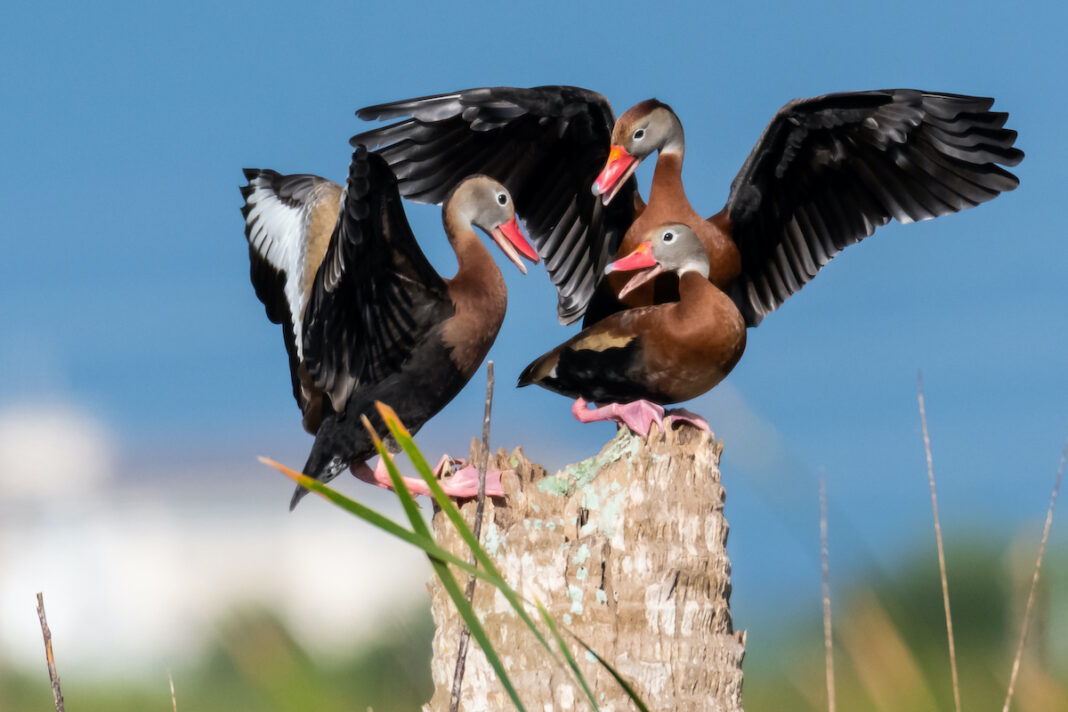The black-bellied whistling duck
NATIVE to the Americas, the black-bellied whistling duck is common along the coasts of the southern states of the USA. It breeds mainly from the southernmost regions of the States, through Mexico and tropical Central America to central South America. These are very attractive, distinctive birds with long pink legs and reddish bills. The striking plumage is layered chestnut on the neck and upper wings, with a bold white wing stripe, then black underparts and tail. The southern race, which occurs south of the Panama Canal, has a grey breast, similar to the head colour seen in both subspecies. Males and females look the same. The ducklings are particularly gorgeous with contrasting stripes in their down feathers.
They are noisy birds, with a clear whistling call. Their whistling duck relatives were formerly known as tree-ducks, and actually the black-bellied whistling duck is one of the few that do spend time perching or nest in trees.
Our knowledge of this attractive species begins with the English naturalist George Edwards, who lived from 1694-1773. Edwards abandoned a career in business so that he could travel and see the world. He became renowned for his expert illustrations of birds and mammals and his work A Natural History of Uncommon Birds (1751) included an illustration and description of the black-bellied whistling duck, under the name of “red-billed whistling duck”. His etching was based on a live bird, reputed to have come from the West Indies, which was kept at the Chelsea home of Admiral Charles Wager.

The scientific name Dendrocygna autumnalis was given by Linnaeus, and refers not to the russet autumn colours found in the plumage but to their presence in newly harvested fields, where they like to glean for leftover seeds and any insects disturbed during the harvest. Flocks still forage in agricultural fields in America today and also frequent golf courses and public parks. They seem not to have regular feeding patterns and can be found eating at any time of the day or night. They may wade through shallow water to feed on submerged vegetation. The diet includes a wide variety of plant material, insects, aquatic invertebrates such as snails and tadpoles or small fish. Captive birds will readily take a wheat and breeder pellet mix.
The black-bellied whistling duck is unusual among ducks in forming strong monogamous pair-bonds. If separated, they will call loudly to each other until reunited. The ducks prefer to nest in cavities in a hollow tree but will nest on the ground when necessary. Unlike the nests of many other waterfowl, theirs is not heavily lined with down. Pairs will stay together for many years, and resist typical duck gender roles with both parents sharing the tasks of incubation and rearing of ducklings. They will take to nest-boxes readily in captivity. Females lay quite large clutches of 13-16 eggs and incubation is for an average of 27 days. The ducklings leap from the nest within two days of hatching and will forage straight away. They usually stay close to the parents for up to eight weeks.
Gail Harland lives in Norfolk with her family and a variety of birds and animals.
Find more news and articles like this on the Cage & Aviary Birds website. Subscribe to Cage & Aviary Birds magazine now.


